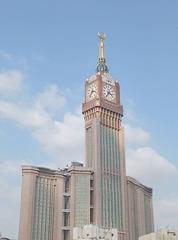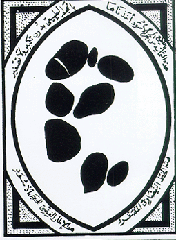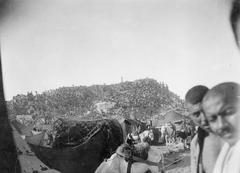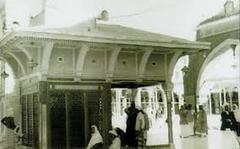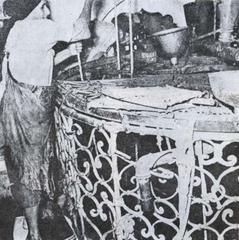Hira Cave Visiting Hours, Tickets, and Comprehensive Guide to Mecca’s Historical Sites
Date: 14/06/2025
Introduction
The Cave of Hira, perched atop Jabal al-Nour (“Mountain of Light”) near Mecca, Saudi Arabia, stands as a cornerstone of Islamic history and spirituality. This sacred site is revered as the location where Prophet Muhammad (peace be upon him) received the first revelation of the Qur’an from Angel Jibril (Gabriel) in 610 CE, marking the inception of Islam. Each year, millions of pilgrims and visitors undertake the challenging ascent to the cave, seeking both spiritual connection and historical insight. This guide provides in-depth information on the Cave of Hira’s significance, practical details for visitors, and a comprehensive look at nearby cultural attractions—including the Hira Cultural District.
Whether your interest is rooted in faith, cultural exploration, or historical curiosity, this article aims to equip you with everything needed for a meaningful and respectful visit to one of Islam’s holiest sites (Leaders MENA; The Islamic Information; trek.zone).
Geographical and Physical Context of the Cave of Hira
Situated near the summit of Jabal al-Nour, approximately 4 kilometers northeast of the Kaaba, the Cave of Hira is a modest chamber—about 4 meters long and 1.5 meters wide—set 270 meters above the mountain’s base. The mountain itself rises to roughly 640 meters above sea level and is a prominent feature in the Hejaz region (Leaders MENA; Zamzam.com). The ascent to the cave is arduous, involving about 1,200 steep, rocky steps, and typically takes between 45 minutes to two hours to complete, depending on fitness and crowding. Railings and carved steps assist climbers, but the journey remains physically demanding (Wasalt Blog; Regency Holidays; 3rooj.com).
Historical Background and Spiritual Significance
Pre-Islamic Significance
Before the advent of Islam, the area surrounding Mecca—including Jabal al-Nour—was known for its spiritual resonance. The Cave of Hira served as a retreat for those seeking solitude and meditation, in line with broader Arabian traditions of reflection in isolated locales.
The Prophetic Retreat and First Revelation
Prophet Muhammad (peace be upon him) would regularly retreat to Hira for solitude and contemplation. During one such retreat in Ramadan, at the age of 40, he received the first verses of the Qur’an, beginning with Surah Al-‘Alaq (96:1-5), from Angel Jibril (The Islamic Information). This pivotal moment marked the birth of Islam and is commemorated during Laylat al-Qadr (the Night of Power), observed in the last ten nights of Ramadan.
Enduring Legacy
The Cave of Hira symbolizes the divine connection, spiritual perseverance, and the Prophet’s quest for enlightenment. The revelations received here shaped not only the course of Islamic faith but also the broader trajectory of world history.
Visiting the Cave of Hira: Practical Information
Visiting Hours
The Cave of Hira does not have strict official opening or closing times. Most visitors prefer to embark on the climb at dawn or late afternoon to avoid the intense midday heat. Seasonal variations and local advisories should be checked before your visit (Wanderlog).
Tickets and Entry
There is no ticket or entry fee for visiting the Cave of Hira. Access is free, but entry to Mecca and its holy sites is restricted to Muslims only, in accordance with Saudi law (wildtrips.net).
Accessibility and Climb Difficulty
The ascent is strenuous and requires a moderate level of fitness. The rocky, steep path makes the climb challenging, especially for the elderly or those with health concerns. Modest, comfortable clothing and sturdy footwear are essential. Bring adequate water, sun protection, and a flashlight if climbing outside daylight hours. The cave’s interior is shaded and cool, offering relief from the desert heat, but can accommodate only a handful of people at a time.
Safety and Health
- Stay hydrated and rest as needed.
- Consult a physician if you have heart, respiratory, or mobility concerns.
- Emergency services are limited on the mountain; ensure your phone is charged for emergencies.
Rituals, Etiquette, and Contemporary Practices
Recommended Practices Inside the Cave:
- Recite the opening verses of Surah Al-‘Alaq.
- Spend time in silent prayer and reflection, emulating the Prophet’s own retreats.
- Maintain cleanliness and respect for the site’s sanctity.
General Etiquette:
- Dress modestly; women should cover their hair and wear loose-fitting clothes.
- Behave respectfully and avoid loud conversation.
- Carry out any trash to preserve the natural environment (adventurebackpack.com).
Nearby Attractions: Hira Cultural District
Adjacent to Jabal al-Nour is the Hira Cultural District—a modern complex enhancing the visitor experience through interactive exhibitions, educational centers, and cultural amenities (Regency Holidays; KSA.com). Covering 67,000 square meters, the district includes:
Key Attractions
- Visitor Center: Provides maps, guides, and orientation tools.
- Revelation Exhibition: Interactive displays narrating the story of the Qur’anic revelation.
- Holy Qur’an Museum: Showcases rare manuscripts, calligraphy, and digital exhibits.
- Exhibition of the Prophet: Highlights the Prophet Muhammad’s life and teachings.
- Hira Park: Offers tranquil green spaces for rest and reflection.
- Cultural Library: Houses books and digital resources on Islamic history and science.
- Culinary Experiences: A variety of restaurants and cafés serve local and international cuisine (Welcome Saudi).
Practical Visitor Information
- District Visiting Hours: Typically 9 AM to 9 PM, with extended hours during pilgrimage seasons. Confirm current times before visiting (Regency Holidays).
- Entry Fees: General admission is free; some exhibitions may require tickets (KSA.com).
- Accessibility: Wheelchair-friendly pathways, prayer areas, and family facilities are available.
- Guided Tours: Multilingual guides can provide deeper historical and spiritual context.
Educational and Cultural Impact
The Hira Cultural District is part of Saudi Arabia’s Vision 2030 initiative, designed to foster intercultural dialogue and enhance religious tourism. Interactive exhibits, educational programs, and events bridge historical tradition with modern technology (Umrah Companions).
Frequently Asked Questions (FAQs)
Q: What are the visiting hours for the Cave of Hira?
A: There are no fixed hours; most visitors climb early or late in the day.
Q: Is there an entry fee?
A: No, visiting the Cave of Hira is free.
Q: How difficult is the climb?
A: The trail is moderately strenuous and requires physical fitness.
Q: Are non-Muslims allowed to visit?
A: No, entry to Mecca and its holy sites is restricted to Muslims only.
Q: Are guided tours available?
A: Yes, especially within the Hira Cultural District.
Visuals and Interactive Media
Incorporate high-quality images of the Cave of Hira, Jabal al-Nour, and the Hira Cultural District with descriptive alt text such as “Pilgrims ascending Jabal al-Nour to Hira Cave” and “Hira Cultural District Visitor Center.” Interactive maps and virtual tours are recommended for better planning (Wanderlog).
Summary and Visiting Tips
Visiting the Cave of Hira is a spiritually rewarding pilgrimage that connects visitors to the very origins of Islam. Prepare for a physically demanding hike, respect local customs, and take time to appreciate the history and significance of the site. The nearby Hira Cultural District further enriches the experience, offering immersive educational opportunities and modern amenities (Leaders MENA; KSA.com). Download the Audiala app for real-time updates, prayer times, and navigation assistance.
Sources and Further Information
- Leaders MENA: Cave of Hira – Cradle of Islamic Revelation
- The Islamic Information: 6 Places to Visit During Hajj Pilgrimage
- Regency Holidays: Hira Cultural District in Makkah
- trek.zone: Hira Cave in Mecca
- KSA.com: Hira Cultural District – A History, Culture, and Tourism Hub in Makkah
- adventurebackpack.com: Mecca Culture
- wildtrips.net: Mecca – What to Visit
- Wanderlog: Hira Cave
- Umrah Companions: Hira Cultural District Tour in Makkah
